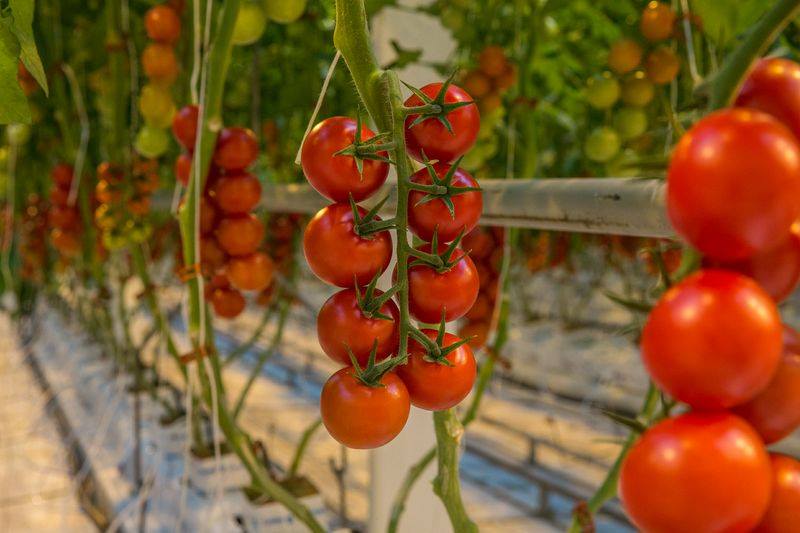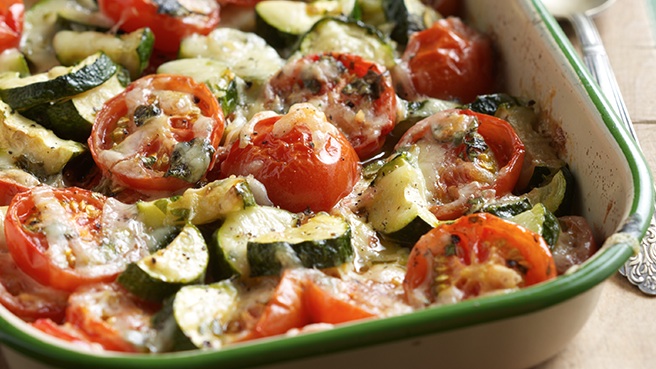Guest post by Jenny Babino, RDN, LD, courtesy of the Maine Academy of Nutrition and Dietetics.
As our home-grown tomatoes enjoy their last few weeks on the vine, we thought it would be a good time to remind you that tomatoes are highly nutritious and should be part of your diet year ‘round — no matter whether you prefer them fresh or in one of their many canned forms.
Two hundred years ago tomatoes were thought to be poisonous! Today, though, tomatoes are tops with consumers. According to the US Dept. of Agriculture, Americans consume 75% of their tomatoes in processed form, with tomato sauce making up the biggest share of that amount (you thought it was ketchup, right?).
What are some of the health benefits of tomatoes?
Tomatoes are a tasty source of many different vitamins, minerals, and healthy plant chemicals (phytonutrients). For example, tomatoes provide vitamins C and A, and ½ cup of tomato sauce provides almost as much potassium as a medium-sized banana.
While it’s true that a diet rich in a variety of fruits and vegetables generally decreases your chances of many chronic diseases, tomato health research is ongoing, and tends to focus on the areas of cancer, heart disease and age-related eye disease. Much of the focus on tomatoes is related to two carotenoids: lycopene and lutein.
- Lycopene is the pigment responsible for giving tomatoes their orange/reddish color and is thought to have the most antioxidant power of all the carotenoid compounds. Because lycopene is naturally only found in a few fruits and vegetables, tomatoes and tomato products provide 85% of the lycopene we get in our diets. Heat processing changes the lycopene to a form that’s more usable to the body.
- Lutein is also a major carotenoid found in tomatoes and is also found in high concentration in the eye. Lutein is thought to help vision and protect against cataracts and age-related eye diseases, such as macular degeneration.
How to incorporate tomatoes into your diet
Most of us know that tomatoes are a staple of Italian cuisine, and that tomatoes are easy to eat as they are — out of your hand as a snack or sliced and added to a salad or sandwich. One important point to keep in mind regarding carotenoids like those in tomatoes: fat increases carotenoid absorption, so cooking or eating tomatoes with a little fat or fat-containing foods is a good idea.
Get even more tomatoes into your diet:
- Dip cherry or grape tomatoes in hummus as a snack or appetizer
- Roast fresh tomatoes; store in the refrigerator and use within a week
- Keep canned, diced and stewed tomatoes on hand for a quick addition to soups, casseroles or of course, chili
- Add diced, fresh tomatoes to scrambled eggs or an omelet
- Cut fresh tomatoes into wedges, drizzle with balsamic vinegar and a little olive oil, salt and pepper and serve as a simple side dish
From Diane: Got a recipe for you!
This recipe for a tomato and zucchini casserole comes from Backyard Farms, which grows tomatoes in a 42-acre hydroponic greenhouse in Madison, Maine. I’ll give you the recipe and then tell you about Backyard Farms and also about the Maine Academy of Nutrition and Dietetics, which provided all the healthy tomato information.
Tomato and Zucchini Casserole
Prep Time: 10 minutes Cooking Time: 40 minutes Serves 6
Ingredients
15 Backyard Farms cocktail tomatoes, halved
1 1⁄2 fresh zucchinis, split and sliced crosswise
1⁄2-inch thick 2 ounces olive oil
2 cloves garlic, sliced thin
6 ounces Gruyere cheese, shredded
1 tablespoon fresh oregano leaves
1 tablespoon chopped parsley
Preparation
Preheat oven to 425° F.
Toss the zucchini, tomatoes, garlic and herbs with the olive oil, season with salt and pepper, and spread evenly in a 9” x 9” ceramic baking dish.
Bake for 20 minutes.
Top with Gruyere cheese, reduce oven temperature to 350° F and continue to bake for an additional 20 minutes.
Serve warm.
Recipe provided for Backyard Farms by Becky Lee Simmons, Chef/Owner of Katahdin Restaurant Wood Fire Grill and Bar, and Chef Ken Biggs.
About Backyard Farms
Why would you name a company that grows tomatoes in a 42-acre hydroponic greenhouse Backyard Farms? Here’s what it says on the company website. “We named our company Backyard Farms for a simple reason: We’re trying our best to bring the same dedicated attention to our plants as you would to your own backyard garden.”
To that end, they use a “personal gardener” system to grow the tomatoes. Each crop care worker maintains 10 rows of plants with his/her name on them and cares for the plants from the time they arrive as 12” seedlings until the time they are replaced.
Since the tomatoes aren’t grown in soil, they can’t be considered organic, but are non-GMO and pesticide-free thanks to integrated pest management (they grow good bugs to eat bad bugs so they don’t have to use pesticides.) They also maintain a population of 30,000 bees to pollinate the plants.
They grow tomatoes year round and sell them only to stores that can get them on the shelves within 48 hours of being picked. Their largest customers are Hannaford, Whole Foods, Shaws and Market Basket.
You can learn more about Backyard Farms and find some more yummy tomato recipes on their website.
About the Maine Academy of Nutrition and Dietetics
Whenever I have a question about nutrition, I always turn to the Maine Academy of Nutrition and Dietetics (MAND) for answers. More than 300 dietitians and dietetic technicians throughout Maine belong to MAND, so I have access to lots of expertise.
For instance, this guest post on tomato nutrition was written Jenny Babino, a licensed dietitian and registered dietitian nutritionist. If you browse through the Nom Nom section of Catching Health, you’ll find several guest posts courtesy of MAND. All are based on accurate, reliable, science-based nutrition information. You can learn more about what MAND offers on its website.
What do you call them?
Tomatoes or tomahtoes?





Leave A Comment